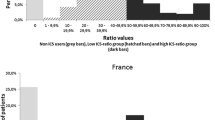Abstract
Background Despite of pharmacists’ specialized knowledge of medication and his/her regular contact with patients, the expertise of the pharmacist may not be used enough yet. Furthermore, the potential of pharmacy dispensing data is underestimated. Objective To provide targets for tailored interventions in asthma patients and to illustrate the potential value of pharmacists in the identification of these targets using individual pharmacy dispensing data. Setting We performed a cross sectional retrospective analysis assessing the quality of asthma patients’ pharmacotherapeutic treatment. Method Drug dispensing data from 2008 to 2009 were retrieved from a Dutch pharmacy database. All asthma patients were screened for potential suboptimal pharmacotherapy in 2009. Results were projected to a single community pharmacy to provide an estimate of the number of patients eligible for potential interventions. Main outcome measures (1) frequent use of short-acting β-agonists without preventive medication, (2) concomitant use of β-blockers, (3) multiple short courses of oral corticosteroids without using inhaled corticosteroids and 4) use of long-acting β-agonist without inhaled corticosteroids. Results A total of 8,504 patients were eligible for analysis of the quality of their asthma treatment. 20.9 % of all asthma patients used >100 DDD short-acting β-agonists per year, whereas between 21.2 % (≥400 DDD) and 31.4 % (100–199 DDD) of these patients did not receive preventive medication. Approximately 5.2 % of the asthma patients are using β-blockers concomitantly and 21.8 % of them received non-cardioselective β-blockers. 6.3 % of the asthma patients received two or more oral courses of corticosteroids in 2008 and 17.4 % of these patients did not receive inhaled corticosteroids in 2009. 2.9 % of the patients used a long-acting β-agonists without inhaled corticosteroids. 8.4 % of the asthma patients using both long-acting β-agonists and inhaled corticosteroids received these drugs in two separate inhalers. We estimated that about 400 asthma patients could be identified in an average pharmacy population (8,000 patients) and 33 (95 % CI 22–44) of these patients would be eligible for interventions. Conclusion This study shows the potential for pharmacists to use their own pharmacy records to identify suboptimal therapy of asthma patients, who may be targets for tailored interventions.

Similar content being viewed by others
References
Global Initiative for Asthma (GINA). Global strategy for asthma management and prevention. Updated 2012. http://www.ginasthma.org [Accessed Sept 2012].
Geijer RMM, Chavannes N, Muris JWM, Sachs APE, Schermer T, Smeele IJM NHG-Standaard Astma bij volwassenen.Available at: http://nhg.artsennet.nl/kenniscentrum/k_richtlijnen/k_nhgstandaarden/Samenvattingskaartje-NHGStandaard/M27_svk.htm Accessed Oct 2012. Huisarts Wet 2007; 50(11):537–551.
Rabe KF, Vermeire PA, Soriano JB, Maier WC. Clinical management of asthma in 1999: the asthma insights and reality in Europe (AIRE) study. Eur Respir J. 2000;16(5):802–7.
Soriano JB, Rabe KF, Vermeire PA. Predictors of poor asthma control in European adults. J Asthma. 2003;40(7):803–13.
Bereznicki BJ, Peterson GM, Jackson SL, Walters EH, Fitzmaurice KD, Gee PR. Data-mining of medication records to improve asthma management. Med J Aust. 2008;189(1):21–5.
Armour CL, Lemay K, Saini B, Reddel HK, Bosnic-Anticevich SZ, Smith LD, et al. Using the community pharmacy to identify patients at risk of poor asthma control and factors which contribute to this poor control. J Asthma. 2011;48(9):914–22.
Schatz M, Nakahiro R, Crawford W, Mendoza G, Mosen D, Stibolt TB. Asthma quality-of-care markers using administrative data. Chest. 2005;128(4):1968–73.
Winterstein AG, Hartzema AG. Pharmacy-specific quality indicators for asthma therapy. Res Social Adm Pharm. 2005;1(3):430–45.
Klomp H, Lawson JA, Cockcroft DW, Chan BT, Cascagnette P, Gander L, et al. Examining asthma quality of care using a population-based approach. CMAJ. 2008;178(8):1013–21.
Stuurman-Bieze AG, van den Berg PB, Tromp TF, de Jong-van den Berg LT. Computer-assisted medication review for asthmatic patients as a basis for intervention. Constructing and validating an algorithmic computer instrument in pharmacy practice. Pharm World Sci. 2004;26(5):289–96.
Schirm E, Monster TB, de Vries R, van den Berg PB, de Jong-van den Berg LT, Tobi H. How to estimate the population that is covered by community pharmacies? An evaluation of two methods using drug utilisation information. Pharmacoepidemiol Drug Saf. 2004;13(3):173–9.
van Boven JF, de Jong-van den Berg LT, Vegter S. Inhaled corticosteroids and the occurrence of oral candidiasis: a prescription sequence symmetry analysis. Drug Saf. 2013;36(4):231–6.
WHO Collaborating Centre for Drug Statistics Methodology, Guidelines for ATC classification and DDD assignment. Oslo, 2012. Available at http://www.whocc.no/atcddd Accessed Oct 2012.
Pont LG, van der Werf GT, Denig P, Haaijer-Ruskamp FM. Identifying general practice patients diagnosed with asthma and their exacerbation episodes from prescribing data. Eur J Clin Pharmacol. 2002;57(11):819–25.
Osborne ML, Vollmer WM, Johnson RE, Buist AS. Use of an automated prescription database to identify individuals with asthma. J Clin Epidemiol. 1995;48(11):1393–7.
Wong MD, Manley RT, Stettin G, Chen W, Salmun LM. Intervention to reduce unnecessary dispensing of short-acting {beta}-agonists in patients with asthma. Ann Pharmacother. 2010;44(4):623–9.
Gaist D, Hallas J, Hansen NC, Gram LF. Are young adults with asthma treated sufficiently with inhaled steroids? A population-based study of prescription data from 1991 and 1994. Br J Clin Pharmacol. 1996;41(4):285–9.
Davidsen JR, Hallas J, Sondergaard J, Christensen RD, Siersted HC, Hansen MP, et al. Association between prescribing patterns of anti-asthmatic drugs and clinically uncontrolled asthma: a cross-sectional study. Pulm Pharmacol Ther. 2011;24(6):647–53.
Salpeter S, Ormiston T, Salpeter E. Cardioselective beta-blockers for reversible airway disease. Cochrane Database Syst Rev 2002;(4)(4):CD002992.
Brooks TW, Creekmore FM, Young DC, Asche CV, Oberg B, Samuelson WM. Rates of hospitalizations and emergency department visits in patients with asthma and chronic obstructive pulmonary disease taking beta-blockers. Pharmacotherapy. 2007;27(5):684–90.
Veninga CC, Denig P, Pont LG, Haaijer-Ruskamp FM. Comparison of indicators assessing the quality of drug prescribing for asthma. Health Serv Res. 2001;36(1 Pt 1):143–61.
Rodrigo GJ, Moral VP, Marcos LG, Castro-Rodriguez JA. Safety of regular use of long-acting beta agonists as monotherapy or added to inhaled corticosteroids in asthma. A systematic review. Pulm Pharmacol Ther. 2009;22(1):9–19.
van der Palen J, Klein JJ, van Herwaarden CL, Zielhuis GA, Seydel ER. Multiple inhalers confuse asthma patients. Eur Respir J. 1999;14(5):1034–7.
Neville RG, Hoskins G, Smith B, Clark RA. How general practitioners manage acute asthma attacks. Thorax. 1997;52(2):153–6.
Nelson HS, Weiss ST, Bleecker ER, Yancey SW, Dorinsky PM. SMART Study Group. The salmeterol multicenter asthma research trial: a comparison of usual pharmacotherapy for asthma or usual pharmacotherapy plus salmeterol. Chest. 2006;129(1):15–26.
Rider NL, Craig TJ. A safety review of long-acting beta2-agonists in patients with asthma. J Am Osteopath Assoc. 2006;106(9):562–7.
DiSantostefano RL, Davis KJ. Prescription patterns in asthma patients initiating salmeterol in UK general practice: a retrospective cohort study using the general practice research database (GPRD). Drug Saf. 2011;34(6):511–20.
Hammerlein A, Muller U, Schulz M. Pharmacist-led intervention study to improve inhalation technique in asthma and COPD patients. J Eval Clin Pract. 2011;17(1):61–70.
De Gier JJ. Commentaren Medicatiebewaking. ISBN 978-90-74027-00-7. Houten: Health Base; 2012–2013.
Self T, Soberman JE, Bubla JM, Chafin CC. Cardioselective beta-blockers in patients with asthma and concomitant heart failure or history of myocardial infarction: when do benefits outweigh risks? J Asthma Dec. 2003;40(8):839–45.
Chafin CC, Soberman JE, Demirkan K, Self T. Beta-blockers after myocardial infarction: do benefits ever outweigh risks in asthma? Cardiology. 1999;92(2):99–105.
Bereznicki BJ, Peterson GM, Jackson SL, Walters H, Fitzmaurice K, Gee P. Pharmacist-initiated general practitioner referral of patients with suboptimal asthma management. Pharm World Sci. 2008;30(6):869–75.
Stuurman-Bieze AG, de Boer WO, Kokenberg ME, Hugtenburg JG, de Jong-van den Berg LT, Tromp TF. Complex pharmaceutical care intervention in pulmonary care: part A. The process and pharmacists’ professional satisfaction. Pharm World Sci. 2005;27(5):376–84.
de Vries TW, van den Berg PB, Duiverman EJ, de Jong-van den Berg LT. Effect of a minimal pharmacy intervention on improvement of adherence to asthma guidelines. Arch Dis Child. 2010;95(4):302–4.
Armour C, Bosnic-Anticevich S, Brillant M, Burton D, Emmerton L, Krass I, et al. Pharmacy asthma care program (PACP) improves outcomes for patients in the community. Thorax. 2007;62(6):496–502.
Stuurman-Bieze AG, Hiddink EG, Van Boven JF, Vegter S. Proactive pharmaceutical care interventions improve patients’ adherence to lipid lowering medication. Annals of Pharmacotherapy 2013. In press.
Van Boven JFM, Hiddink EG, Stuurman-Bieze AGG, Postma MJ, Vegter S. Structured medication surveillance for improving adherence to bisphosphonate therapy offers perspectives for cost-effective pharmaceutical care. Pharm Weekbl Wet Platf. 2011;5(8):160–6.
Acknowledgments
The authors would like to thank Sipke Visser for database assistance.
Funding
This research received no specific grant from any funding agency in the public, commercial or not-for-profit sectors.
Conflicts of interest
The authors declare no conflict of interest.
Author information
Authors and Affiliations
Corresponding author
Rights and permissions
About this article
Cite this article
van Boven, J.F.M., Hiddink, E.G., Stuurman-Bieze, A.G.G. et al. The pharmacists’ potential to provide targets for interventions to optimize pharmacotherapy in patients with asthma. Int J Clin Pharm 35, 1075–1082 (2013). https://doi.org/10.1007/s11096-013-9829-1
Received:
Accepted:
Published:
Issue Date:
DOI: https://doi.org/10.1007/s11096-013-9829-1




